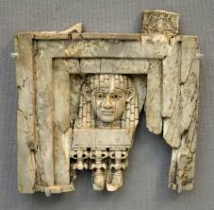
A recurrent iconographic motif of Phoenician art during the early 1st millenium BCE is the “Woman at the Window.” Sometimes called by researchers “Astarte at the Window,” the motif occurs with such frequency—known examples number in the thousands—and in so many different mediums (ivory, stone, wood, bone), that it is well worth asking what it may have meant to the ancestors.
Although minor variations occur, the type is surprisingly consistent. A woman's face peers out from a window. The window itself is generally back-set in a triple recess; she looks out over a balustrade supported by four (occasionally three) elaborately-carved columns. The woman is characterized by an elaborate ringlet coiffure—perhaps a wig—bekohled eyes, and prominent ears.
Early researchers associated the motif with a cult of sacred prostitution, but contemporary scholars have laid this sacred cow of Biblical research to rest. No evidence exists for such an institution in any ancient Semitic culture; such claims in antiquity have proved to be at second- and third- hand, and are invariably attributed to other people. Whoever the Woman at the Window may be, she is no “hierodule.”
The monumental architecture of the window clearly indicates that this is a very special woman indeed; the window is an elaborate frame for what seems most likely to be a divine epiphany. Although no known examples are inscribed, it is not unreasonable to think that we may here be gazing upon the face of a goddess, and although the cultures of the Eastern Mediterranean coast knew numerous goddesses, we may well suspect that this may be the goddess known variously as Astarte, Ashtárt, Ashtéret, and Ashtarót.
 Simply beautiful, so evocative. I can't wait for my maiden to receive hers from Saint Nicolas this Christmas. Blessings xx
Simply beautiful, so evocative. I can't wait for my maiden to receive hers from Saint Nicolas this Christmas. Blessings xx





















